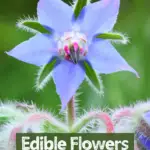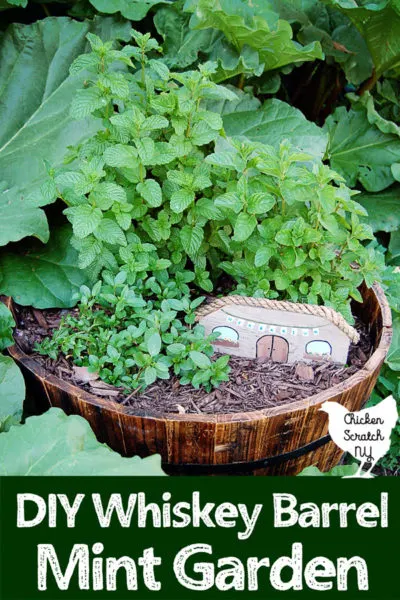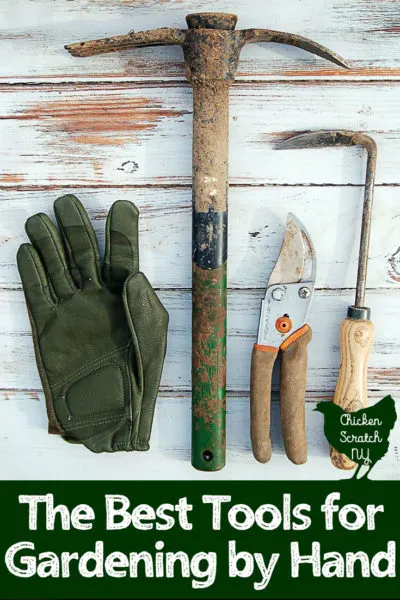When the worlds of flower gardening and vegetable gardening meet, we get edible flowers! Edible flowers are more than just a pretty face, they can add flavor and texture to baked goods, salads and even cocktails.
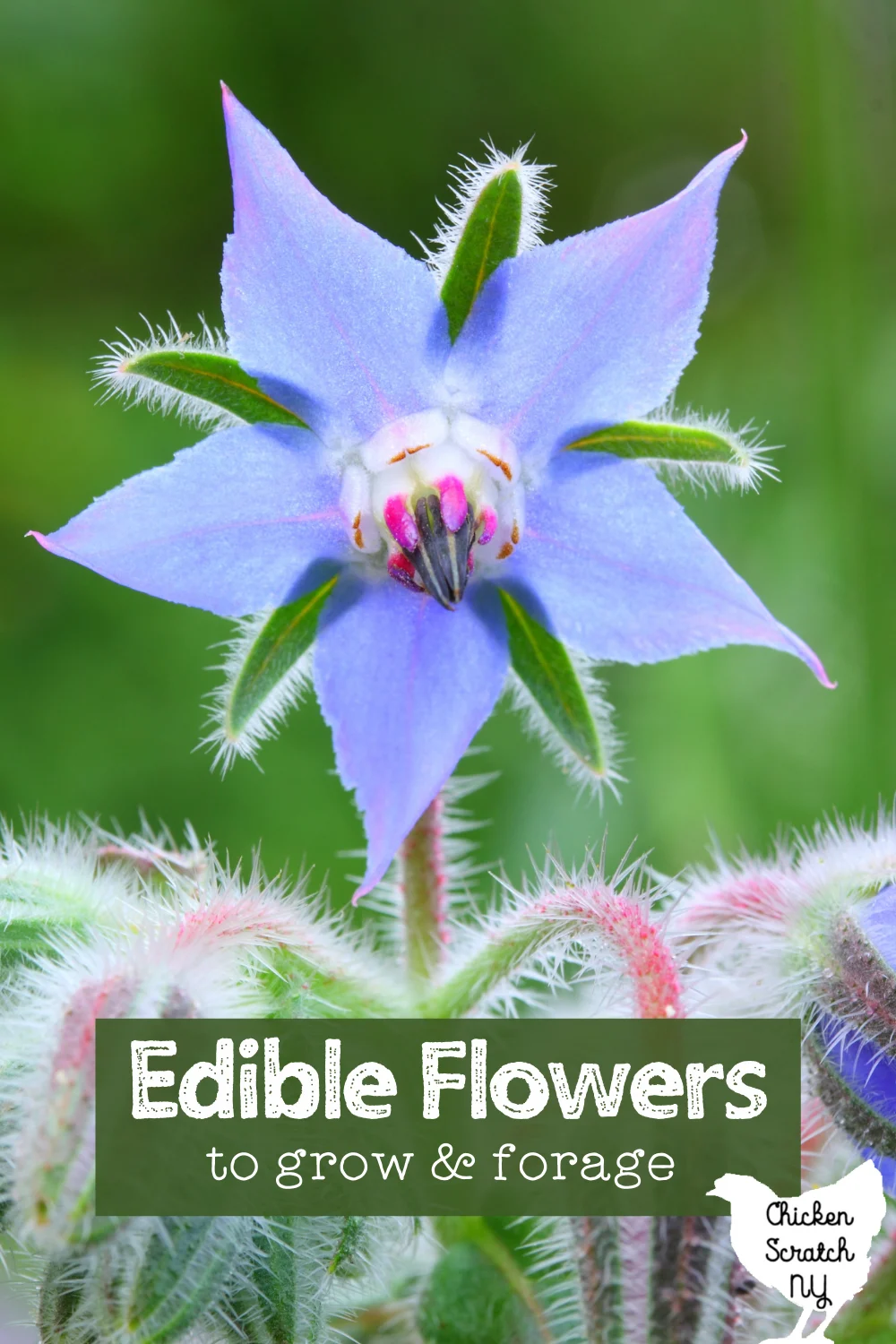
You might be surprised to find a scattering of flowers on your dish and assume they’re just there for looks. But there are quite few pretty flowers that pack a flavorful punch!
Growing flowers to eat isn’t much different from growing any other type of flower. The main difference is you don’t want to put anything on them, as far as fertilizer or pesticides, that you wouldn’t want to eat.

How to Eat Edible Flowers
Every year my daughters and I head out the lawn to eat a few violets. I’m not sure how the tradition started but it’s been a yearly thing for a few years.
Of course, there are more ways to enjoy edible flowers than just tossing them in your mouth!
Garnish
The most common way to use edible flowers is as a garnish. You can add flowers to the top of a salad, pile them on a cake, or freeze them with water in an ice cube tray to add to a summer drink or cocktail.
Make sure your guests know the flowers are actually part of the meal and not just something to make it look pretty!
Syrup
Syrups are versatile kitchen ingredient, they can be added to cold seltzer for a refreshing drink, spooned over ice cream, shaken up in a cocktail or brushed over baked goods for an extra kick of flavor.
Simple syrup is made by heating sugar and water in a 2:1 ratio until the sugar dissolves into the water. You can add flowers to flavor the syrup, like in this recipe for Violet Syrup.
Jelly
Jelly is basically really thick syrup. You can make jelly out of just about any type of liquid with the addition of sugar and pectin.
The high acidity of the added sugar keeps the jelly shelf-stable when properly preserved through water bath canning. Dandelion, rose, and violet are the most common floral jellies.
Interested in preserving the harvest? Check out my Favorite Canning & Preserving Books
Compound Butter & Cheese
Compound butter is made by combining softened butter with pieces of something flavored (herbs, flowers or fruit, etc.) and then rolling it into a log or shaping it into molds. The butter absorbs the flavors of the additions.
The flavored butter can be used just like regular butter, if you really want the flavor to shine try serving it with a toasted piece of homemade bread.
Strong savory flavors like chive, nasturtium, and sage blossoms will work well in butter. You can also make a similar dish using softened goat or cream cheese for a tangier flavor.
Flavored Oils & Vinegars
You can use edible flowers to add flavor and pizazz to vinegar and oils. The flavored vinegar and oil can be used to make salad dressings, marinades or sprinkled over roasted vegetables.
The high acid content in flavored vinegars make them safer for the home chef than oils. Homemade flavored vinegar can
Homemade flower infused oils should be stored in the fridge and consumed within a few days to prevent botulism.
Edible Flowers to Plant in your Garden
Edible flowers fall into both annual and perennial growth habits. Annuals like basil and nasturtium can be planted right along with your vegetable garden.
Plants like sage and rose bushes that come back year after year should be put in a spot where they can grow back year after year. I put mine in my herb garden but they’d be lovely additions to a flower bed.
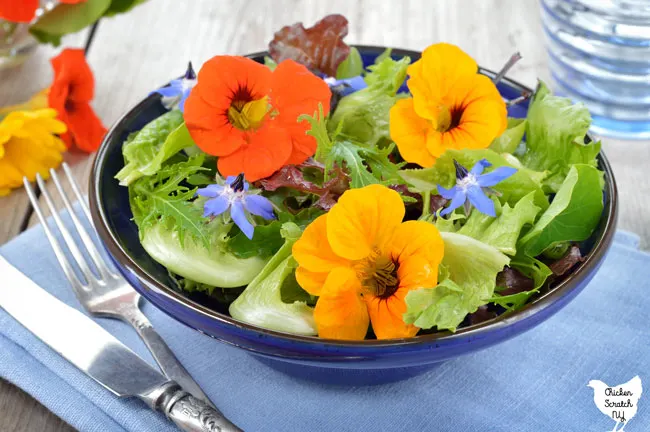
Many edible flowers are vigorous re-seeders. They are annuals, the plant itself will only survive for one season but if you leave the flowers on the plant and they ‘go to seed’ you will find yourself surrounded by millions of tiny seedlings the next spring.
I like to keep the re-seeders in my herb garden where I can leave them be. If they were in the vegetable garden I would end up digging up and possibly killing a lot of healthy plants. Dill, chamomile, calendula and borage are all very happy to re-seed themselves.
Basil
Basil flowers offer the same great basil flavor with a slightly milder flavor. If you’ve ever grown basil I’m sure you’re familiar with the angular flowers that crown the stalks, they don’t look much like traditional flowers!
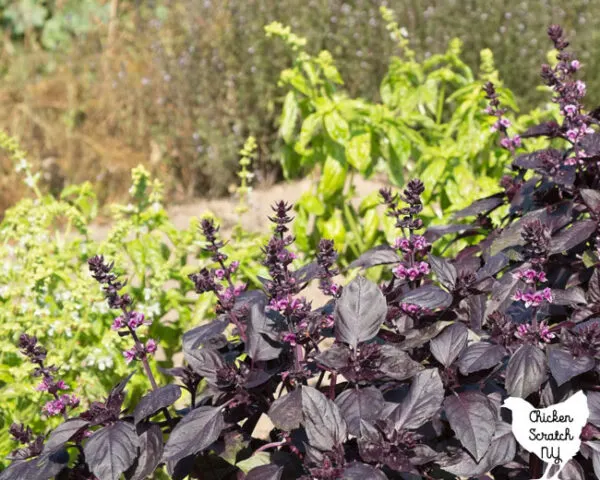
I like to grow a variety of basils in my garden, if you’re interested in a change from the standard green check out a purple variety for a splash of color.
Recipe idea: Basil Flower Pesto
Borage
Borage flowers are sort of crazy looking, they have five pale blue petals with a spiky looking cone in the center, they bloom in large clusters at the top of the plants, and the flowers themselves usually hang down.
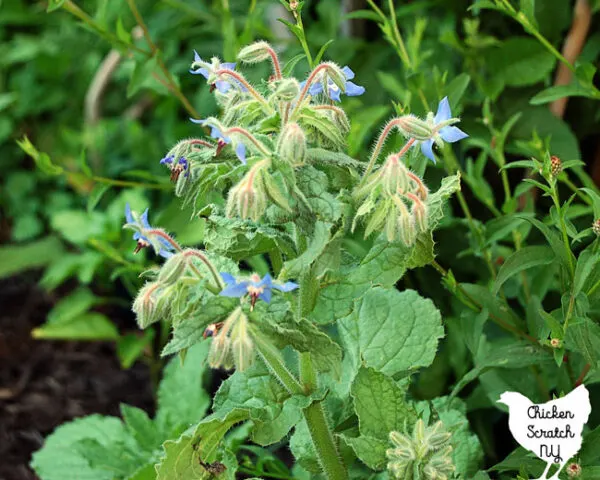
They have a subtle cucumber flavor that you can also find in the leaves. The plants are quite big, getting up to 3 feet tall and wide so make sure you give them room. The plants are really fuzzy and easy to identify.
Even if you hate cucumbers this plant is worth growing for the bees, they love it! I know my plants are always covered and since they’re so easy to grow it’s a no-brainer.
I planted borage from seed 3 years ago and now I just wait to see where the new ones will pop up. They are easy to identify when they’re small so you can pull them out and they never get out of control like some other re-seeders.
Recipe idea: Sparkling Borage Cocktail
Calendula
Calendula or Pot Marigold is the most medicinal herb on this list. The flowers can be infused in oil to make soaps, lotions or salves.
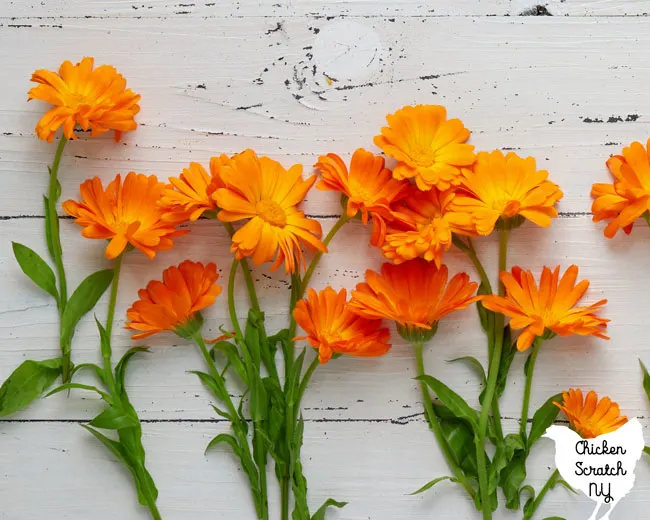
Of course you can also eat the flowers, or it wouldn’t be on this list! Calendula is easy to grow from seed and it is happy to re-seed all over the place.
The bright flowers come in warm shades of yellow, red, and orange. The Calendula variety Resina was developed to have more resin in the petals, intended for all those skin and beauty purposes.
I love the controlled chaos you get from planting out of a packet of mixed colors like this Pacific Beauty Blend. The bright yellow and orange of the flower petals can be used as a natural food dye.
Recipe idea: Calendula Iced Tea
Chamomile
Chamomile is most known for an herbal tea made from the flowers. The small white-petaled flowers with yellow centers grow on thin, wiry stems with lacy, delicate leaves.
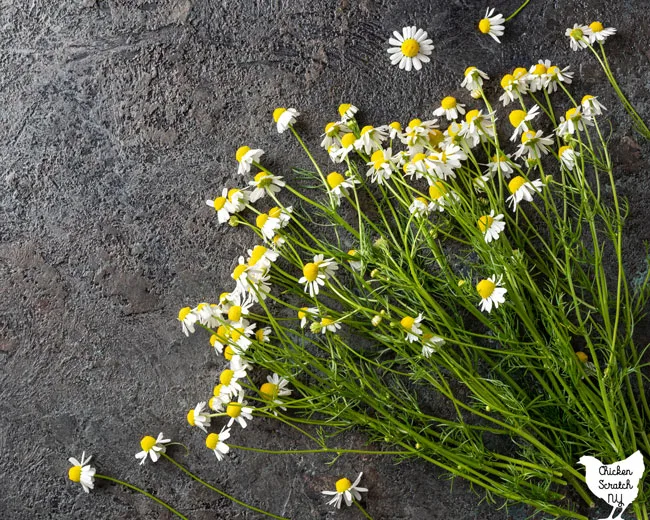
The apple-scented flowers attract lots of bees and pollinators. Chamomile is easy to grow from seed, either started indoors and transplanted or directly seeded in the garden.
It’s a re-seeding annual, I haven’t noticed it getting out of control. The plants tend to stay in one area and come back denser and denser every year. I haven’t reached the point where I need to start dividing them yet but I’m sure it’s coming.
Recipe idea: Chamomile Flower Tea Cookies
Chives
Chives blossoms are one coolest looking edible flowers. They look like round purple balls when fully open.
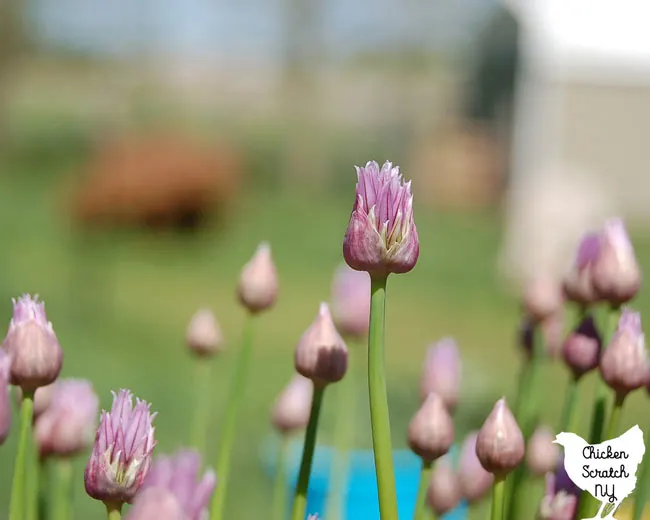
Chive flowers are very popular with bees, mine are usually hosting a bumble bee or two the entire time they’re blooming.
The pinky-purple blossoms have a subtle onion flavor, garlic chives have white flowers, and a garlicky flavor. Chives can be grown from seed but they are easy to divide and are more often grown by separating large clumps.
Recipe idea: Chive Flower Compound Butter
Daylily
Daylilies aren’t just for hats these days. You can eat the flowers, alone or stuffed with flavored soft cheese. The flowers only last a day so snagging a few hear and there to snack on won’t ruin the look of your flower bed.

Daylily flowers can have a laxative effect so take it slow and don’t eat too many at once. It’s also important to only eat daylilies, other types of lilies can be toxic.
Recipe idea: Herbed Goat Cheese Stuffed Daylilies
Dill
Dill is another one of those plants that I grow for odd reasons. I do enjoy it, especially in a creamy onion & dill dip but I really let it go crazy for the swallowtail butterflies.

Dill is easy to grow, it bolts quickly in the heat and will re-seed itself like crazy. You can grow Tetra dill if you’re more interested in the dill weed (leaves) or one of the more classic types like Bouquet if you want lots of seed.
Recipe idea: Dill Pickles with Dill Flowers
Nasturtium
Nasturtium flowers are one of the first that pop into my head when I think of edible flowers. The cheerful blossoms can be grown in all sorts of shades of red, orange & yellow.
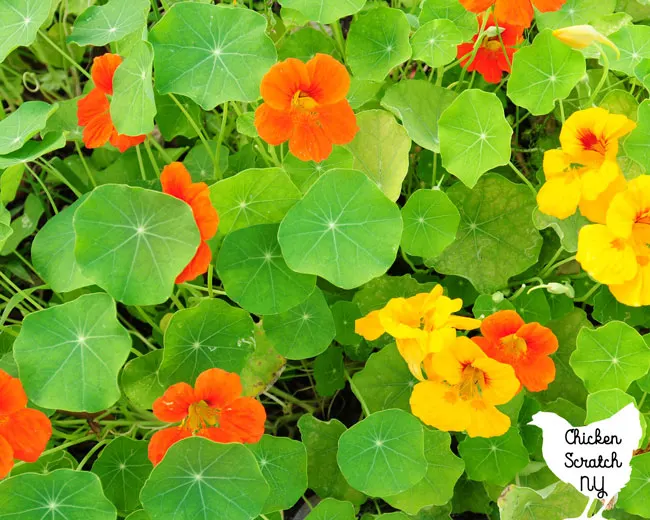
Both the unique shaped leaves and the cheerful petals have a peppery flavor. Even the seed pods are edible!
Nasturtium are easy to start from seed, they do best when sown directly in the garden where poor soil helps produce more flowers. When grown in nitrogen rich soil the plants produce more leaves and fewer flowers.
Recipe idea: Nasturtium Flower Infused Vinegar
Radish
A common theme with edible flowers is they have a slightly calmer flavor than the rest of the plant they come from. Radish flowers have the same peppery flavor as radish roots but with less bite.
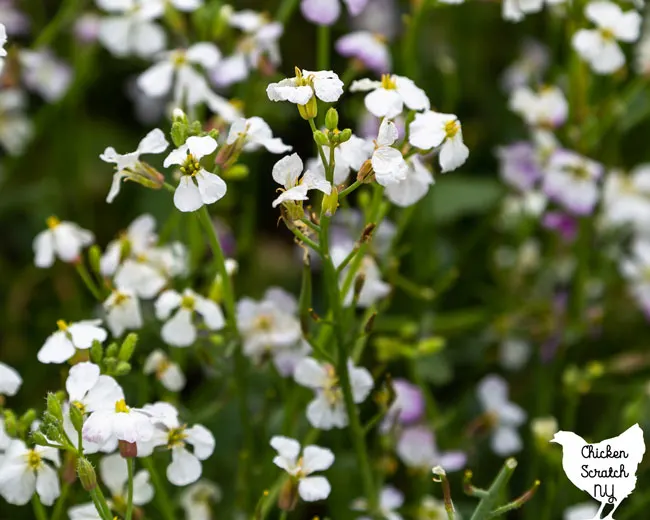
I don’t actually like radishes, but I grow them every year for a few reasons. They always flower go to seed and now I can’t wait to sample the flowers to see if I like the more muted flavor.
Along with adding the flowers to a salad or soup as a garnish you can also eat the seed pods that show up after the flowers bloom.
Recipe idea: Pickled Radish Seed Pods
Rose
Roses have a reputation for being picky and hard to grow. Rugosa roses are known for being the exact opposite.
The trade off for super hardy plants, prolific flowers and giant rose hips are an almost weedy level of growth and lots of spiky thorns.
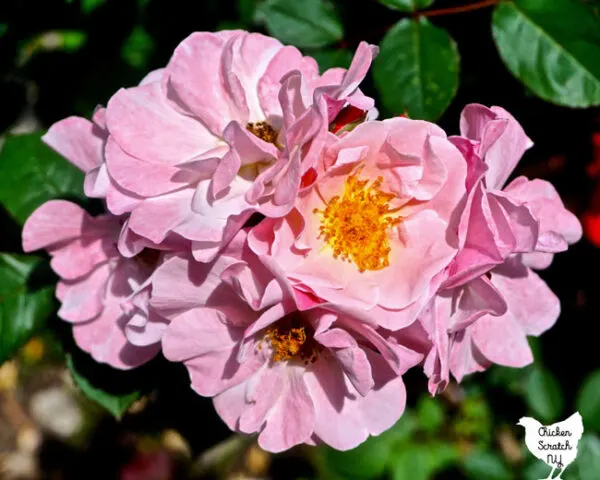
Rose petals have a floral flavor to match their fragrance. You can eat the petals as part of a salad, make rose sugar by layering sugar and petals in a closed container or turn them into rose syrup to flavor drinks or baked goods.
Recipe idea: Rose Petal Syrup
Sage
On the rare occasion I’m entertaining the herb garden I like to encourage my guests to sample the sage flowers.
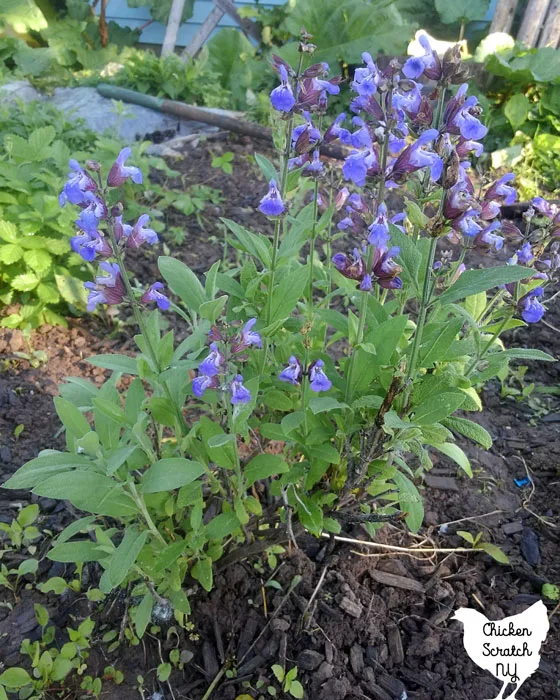
The pretty purple flowers have a delicate taste that doesn’t have the overwhelming flavor you get from the leaves. Sage is grown as a perennial in zones 4-8, I have one plant in my garden that I use every year to make my Thanksgiving Maple & Sage Scalloped Sweet Potatoes.
Recipe idea: Sage Blossom Pesto
Wild Edible Flowers
You aren’t limited to growing your own delicious flowers in your garden either! A quick walk in the yard might lead you to a pretty salad or floral jelly.
Just like with the flowers you grow, it’s important to make sure you aren’t picking wild growing flowers from areas treated with anything. I hate (and neglect) my lawn and I know anything growing out there is free from any type of pesticides or fertilizer.
Clover
As a self-professed lawn hater I’m happy to report that most of my front lawn is covered in clover, dandelions and bees.
The short white clover you usually find on your lawn and the larger pink and red clovers you might find in an overgrown garden (not that I’m familiar with that) or a field are all edible

Clovers are huge bee plants, and unsurprisingly clover honey is sought after for its light color and mild flavor.
I remember sitting on the lawn as a kid, sucking the nectar out of clover flowers. To be fair it was the 90’s, we didn’t have the internet yet and had to find way to amuse ourselves.
Recipe idea: White Clover Pudding
Dandelions
Dandelions are my favorite flowers, few things in this world make me happier than a whole field overgrown with balls of sunshine.
Along with being synonymous with spring and sunshine dandelions are a delicious and versatile kitchen ingredient.
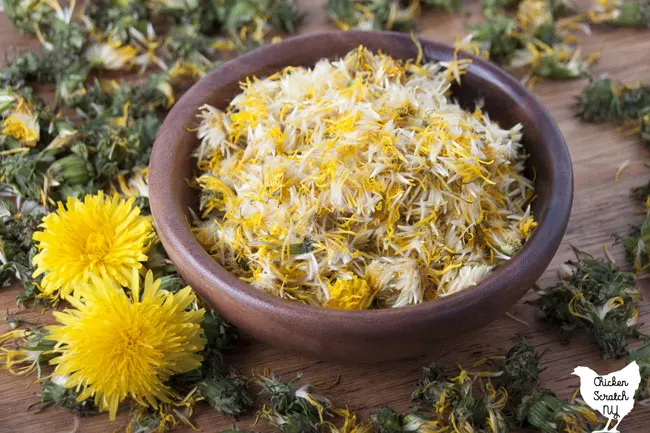
You can eat the leaves like spinach (early season leaves are less bitter), roast the roots to use as a coffee substitute and of course, eat the flowers.
The green sepals have more of that bitter flavor and should be removed. The flowers can then be made into dandelion wine, jelly or dandelion flower cookies.
Recipe idea: Dandelion Fritters
Violets
Wild violets grow in shady areas, when the plants are happy they’ll take over spreading like crazy. I have a giant patch on the side of my house and I couldn’t be happier with them.

If you’re looking for the best flavor you should seek out European violets, the native north American violets are safe to eat but the subtle flavor can also be described as nonexistent.
Recipe idea: Candied Violets
Check out my Vegetable Garden page for more ideas or start here:

